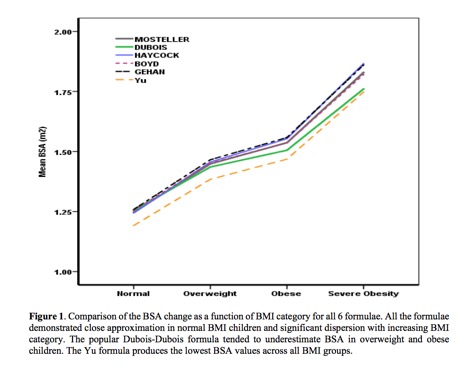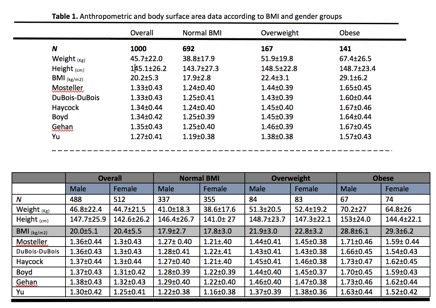NM-302
Effect of Body Mass Index Category on Body Surface Area Calculation in Children Undergoing Cardiac Procedures
Patel J, Nafiu O
University of Michigan, Ann Arbor, MI, USA
Background: In children with cardiac diseases, body surface area (BSA) calculation is used for making critical decisions such as estimation of cardiac index, oxygen consumption and basal metabolic rate (1). Dosing of medications with narrow therapeutic indices is often based on BSA. BSA is calculated using formulae derived from two anthropometric parameters: height and weight (1-5). These equations were either introduced prior to the widespread prevalence of childhood obesity or have not been validated in overweight/obese children. Obesity can have significant influence on estimated BSA results. Obese children have disproportionate weight gain compared to height, and thus have different overall geometric structure compared to children with normal BMI. The concordance of common BSA formulae in a large sample of normal, overweight and obese children is unknown. This study compared BSA data obtained from six formulae across BMI categories in children undergoing non-bypass cardiac procedures.
Methods: Following IRB approval and using de-identified data, we stratified 1000 children ages 2-17yr who underwent various cardiac (non-pump) procedures into three groups: normal weight (BMI <85th percentile), overweight (BMI >85th and <95th percentile), or obese (BMI≥95th percentile). We then used six common BSA formulae to calculate values for each group. These equations were selected because they included pediatric subjects and were derived in studies using direct methods of BSA measurement.
Results: Among the 1000 (mostly Caucasian –76.1%) subjects, 16.7% were overweight while 14.1% were obese. There were slightly more girls, 512 (51.2%). On average, boys were taller, heavier, and had higher BMI and BSA by all the formulae than girls (Table 1). BSA change with BMI category for all 6 formulae demonstrated close approximation in normal BMI children but significant dispersion with increasing BMI category (Fig.1).
Conclusion: In children undergoing elective operations, many of the common BSA estimation formulae demonstrated poor agreement with increasing BMI category. These differences among calculations are so pronounced that they may affect therapeutic interventions. Perioperative care-givers need to be aware of the limitations of these formulae in overweight and obese children. Estimation formulae that consider a child’s obesity status are urgently needed.
References: (1). Arch Intern Med 1916;17:863-71. (2) Cancer Chemother Rep 1970;54:225-35. (3) J Pediatr 1978;93:62- 6. (4) Am J Physiol Endocrinol Metab 2001; 281:E586-91. (5). N Engl J Med1987;317:1098.
Top













